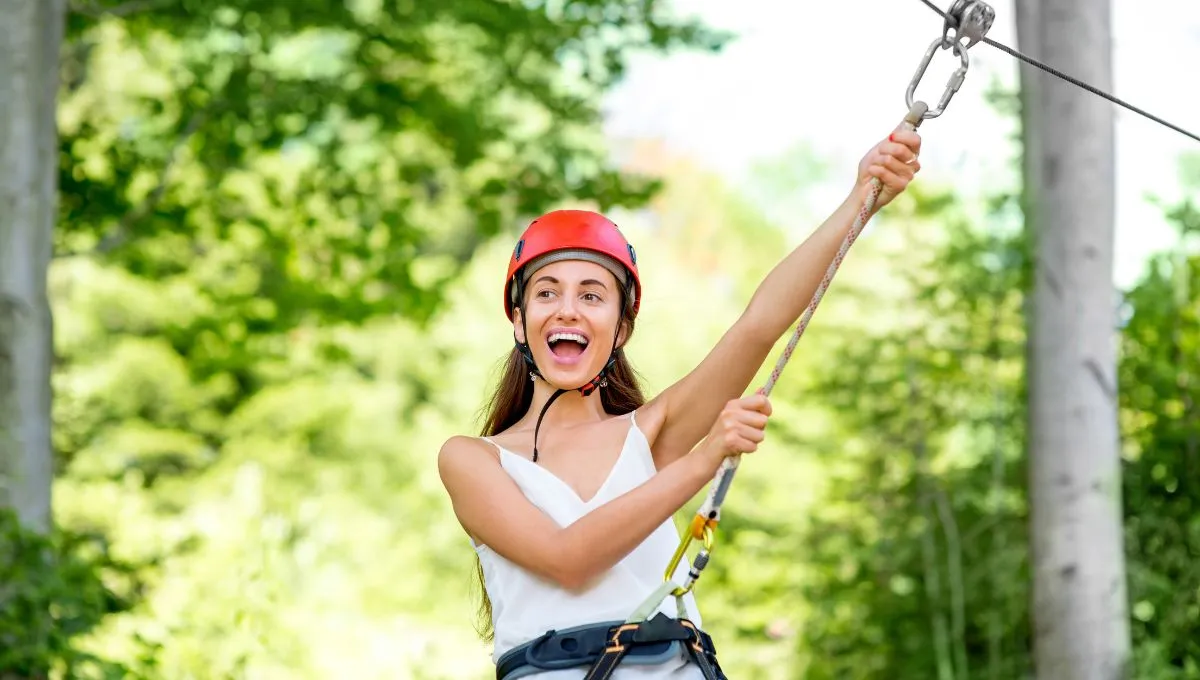
With great excitement increasing for zipline adventures, zoning in on uncertainties and cautions for expectant moms is paramount. Zipline tours have soared in popularity over the last decade. But for pregnant thrill-seekers, understanding safety concerns and health impacts can ensure wise choices. With risks varying by trimester and numerous other considerations, we’ll dive deeply into whether ziplining is safe during pregnancy.
We’ll first discuss key safety worries, including potential dangers and hazards for unborn babies. Next, we’ll weigh physical impacts, including bodily stress factors. Then we’ll explore mental health benefits for moms-to-be. It’s also crucial to evaluate considerations specifically for each trimester and what doctors recommend. Liability issues that operators face will shed light on restrictions. We’ll also spotlight real life testimonials from brave moms who ziplined while pregnant. Common questions surrounding this adrenaline-pumped experience will be addressed too. By the end, you’ll be equipped to make an informed decision about ziplining during the baby bump months. So buckle up and get ready for this wild ride!
Related: Can Pregnant Women Park In Handicap Spaces
Is Zipline Safe for Pregnant Women
Ziplining during pregnancy is a topic that has mixed opinions and experiences. Some women have ziplined while pregnant without any issues, while others advise against it due to the potential risks and discomfort. Ultimately, the decision to zipline while pregnant should be based on your personal comfort level, your doctor’s advice, and the specific ziplining venue’s policies. It is essential to consult with your healthcare provider before engaging in any physically demanding activities during pregnancy.
Safety Concerns
Many expectant mothers have concerns about the safety of ziplining when pregnant. There are some medical risks to consider before embarking on a ziplining adventure while pregnant.
The primary safety concern is the risk of falling. Ziplining does require some physical exertion and balance while suspended on a cable high above the ground. Loss of balance or an accidental release from the pulley could result in a traumatic fall. Many adventure ziplining tour companies require participants to wear safety harnesses to prevent falls. However, even with safety gear, a major fall could still result in injuries to the mother or unborn baby.
Blood pressure is another medical consideration. The excitement and thrill of ziplining can cause a sudden spike in blood pressure. For women with pregnancy-induced hypertension or preeclampsia, these blood pressure elevations could be dangerous. Checking with a doctor is important for anyone with blood pressure issues before ziplining.
There is also a small risk of abdominal trauma from the zipline harness and pulley system putting pressure on the uterus. Proper harness fitting and padding is essential to minimize this risk. Overall, physically fit women with low-risk pregnancies can likely zipline safely, but medical consultation is still advised. Proper precautions, safety gear and experienced guides can help pregnant women enjoy ziplining while minimizing risks.
Physical Health Impacts
Ziplining while pregnant can have various effects on the mother’s physical health that should be considered.
- The adrenaline rush and excitement of ziplining can significantly increase the mother’s heart rate and blood pressure. These spikes in heart rate and blood pressure can be concerning, as high blood pressure in particular poses risks like preeclampsia during pregnancy.
- The pressure from ziplining harnesses and helmets on the abdomen and waist area can temporarily restrict blood circulation. Reduced circulation can be problematic, especially in later pregnancy when circulation already tends to be more restricted. This is something for pregnant zipliners to be mindful of.
- The jolting motion involved with ziplining could potentially detach the placenta from the uterine wall. This placental abruption is very serious and can impair oxygen supply to the baby. However, this risk seems low if the zipline has proper stabilization and the mother ziplines smoothly without excessive jarring movements.
- Repeated muscle contractions used for braking throughout the zipline course can lead to muscle cramps and soreness. Expecting mothers already tend to suffer from leg cramps, so this is an added concern. Proper hydration and stretching before and after ziplining can help mitigate this.
- The strenuous nature of ziplining also increases core body temperature, which may not be ideal in pregnancy. Overheating has been associated with neural tube defects and other issues. Staying cool and hydrated is important.
Overall, pregnant women should closely monitor their physical health when ziplining, and consult their doctor if they have any concerns. With proper precautions, the physical effects can likely be managed.
Mental Health Benefits
Although ziplining is a thrilling physical activity, the mental health benefits it provides should not be underestimated. Many studies show ziplining can have a profoundly positive impact on one’s psychological wellbeing.
The sheer exhilaration of flying down a cable harnessed to a zipline can offer immense stress relief. As you soar above the canopy gazing upon nature’s beauty, your senses are overloaded and everyday worries vanish. The focus ziplining requires similarly provides temporary relief from anxious thoughts.
Conquering the courage required to zipline builds self-confidence. Pushing past fear and apprehension to achieve something daring gives a powerful boost of self-assurance. Many zipliners feel a great sense of accomplishment after overcoming the intimidation factor and succeeding.
Zipline tours are often conducted in groups, providing opportunities to bond with others. Sharing an adventurous experience creates strong social connections. The shared adrenaline rush and feeling of collective accomplishment further strengthens interpersonal bonds.
Mentally detaching from technology and connecting with nature also enhances psychological wellbeing. The natural scenery and serenity of the environment contrasts the digital stimulation of daily life. Ziplining fully immerses you in the present moment.
The euphoric mix of freedom, excitement, accomplishment and connectedness ziplining offers has been found to elevate mood, reduce anxiety and improve confidence. While ziplining requires physical fitness, the mental health benefits are equally impactful.
Related: Coping with Pregnancy-Related Hemorrhoids
Trimester Considerations
When assessing the safety of ziplining during pregnancy, it is important to consider how the risks and recommendations can differ depending on the stage of pregnancy. The three trimesters of pregnancy each come with their own physical changes that can impact a woman’s ability to zipline comfortably and safely.
First Trimester
- During the first trimester, nausea and vomiting are common pregnancy symptoms that could make ziplining very uncomfortable. The jostling motions could aggravate these symptoms.
- Fatigue in early pregnancy could also make it more difficult to fully participate in and enjoy the experience.
- There is a slight increased risk of miscarriage in the first trimester, so some doctors recommend avoiding vigorous physical activity. The forces on the body from ziplining could potentially increase miscarriage risk.
Second Trimester
- Most doctors consider the second trimester the safest time in pregnancy for slightly strenuous activities like ziplining. Risk of miscarriage drops significantly after the first trimester.
- The belly is still not very large at this point, so it may not interfere much with being harnessed. However, the added weight could put more strain on the body.
- Balance shifts as pregnancy progresses, so this could impact comfort and safety on the zipline course. Consider waiting until after the second trimester if unsure.
Third Trimester
- Ziplining is not recommended in the third trimester as the belly is quite large and could get in the way of being properly harnessed.
- The extra weight at this stage also adds significant strain to the body that could increase injury risk on the course.
- Balance and agility are compromised further in the third trimester, making it difficult to safely zipline.
- There are increased risks to the baby in late pregnancy, so doctors advise avoiding potentially dangerous activities.
Doctor Recommendations
While ziplining is a popular adventure activity, some expectant mothers wonder whether it is safe or advised during pregnancy. Guidance from ob-gyns can provide insight. Some considerations from medical experts regarding ziplining while pregnant:
- Many doctors recommend avoiding any adventurous activities that carry even a small risk of falling or abdominal injury. The unpredictability of ziplining may make it especially concerning. Caution is advised during the 2nd and 3rd trimesters when a protruding belly increases chances of impact.
- Ziplining courses often include rough terrain, harnesses, rapid acceleration, and sudden stops. The forces involved could potentially lead to placental abruption or premature labor. Medical professionals generally suggest pregnant women avoid activities with such jarring forces on the body.
- Hormonal changes during pregnancy can affect connective tissues and ligaments, increasing chances of injury. Doctors warn that joints become overly mobile. The high speeds and jerking motions of ziplines may heighten risks. Proper bracing of the abdominal area is unlikely with a zipline harness.
- Though data is limited, some case studies suggest zipline injuries or trauma have led to miscarriages and complications. Many physicians feel there are insufficient safety studies on ziplining while pregnant. The unknown risks often lead them to recommend against ziplining during pregnancy as a precaution.
- Some ob-gyns may approve ziplining in limited circumstances based on the patient’s health history and risk factors. However, nearly all advise avoiding ziplining in the 3rd trimester when risks of falls and placental issues are highest. Caution is urged even in earlier trimesters.
So in summary, many ob-gyns prefer pregnant women avoid ziplining, especially in the 2nd and 3rd trimesters, due to risks of bodily trauma, falls, placental abruption, premature labor, and other complications. While limited ziplining may be approved in some cases, extreme caution is advised by most medical professionals. Expectant mothers should have an open conversation with their doctor before ziplining.
Liability Concerns
Ziplining companies face potential liability issues when allowing pregnant women on tours. There are risks if a woman gets injured or has complications. Companies need to weigh these factors:
- Duty of care – Companies have a responsibility to keep participants safe. Allowing a pregnant woman on a course could be seen as negligent if she gets injured.
- Waivers – While waivers protect companies to an extent, they may not fully protect from a lawsuit if negligence can be proven. Waivers likely do not cover fetal injury.
- Insurance concerns – Insurance companies may exclude coverage for injuries sustained by pregnant participants. Rates could increase if claims are made.
- Reputation – Accidents or issues involving pregnant women could generate negative publicity and damage a company’s reputation.
- Existing policies – Some companies prohibit pregnant women altogether to minimize liability. Others require doctor approval. Strict policies lower liability risk.
- Staff training – Employees should be trained on handling incidents involving pregnant participants. Lack of training may increase liability if issues occur.
- State/local laws – Some jurisdictions prohibit high-risk activities for pregnant women. Companies should be aware of all applicable laws.
Though risky, companies can take steps to reduce liability like requiring doctor notes, securing appropriate insurance, training staff, and modifying harness systems. The potential increase in business may outweigh the risks for some operators. But legal consultation is advised before allowing pregnant participants.
Related: Did You Accidentally Took Mucinex DM While Pregnant
Hear from Moms Who Ziplined While Pregnant
Getting on a zipline may seem daunting for an expecting mom, but many brave women have taken the plunge. Hear what these adventurous mamas have to say about their experiences ziplining during pregnancy:
“I was 32 weeks pregnant when I went ziplining and it was so much fun! I checked with my doctor first who said it would be fine. The staff helped get me comfortably harnessed. The feeling of flying through the air was like nothing I’ve ever experienced. It didn’t put any strain on my body and was perfectly safe for me and the baby.”
Anne S., Houston, TX, Ziplined at 32 Weeks Pregnant
“My husband surprised me with a ziplining adventure when I was 18 weeks pregnant. I was scared at first but the guides made me feel totally comfortable. Ziplining turned out to be gentle gliding that didn’t jostle me at all. It was actually very relaxing! I’m so glad I got to have this unique experience.”
Lauren R., Denver, CO, Ziplined at 18 Weeks Pregnant
“We went ziplining as part of our babymoon when I was 6 months pregnant. The staff was wonderful and took extra care of me. Ziplining was exhilarating and not stressful on my body. I felt safe the entire time and had a blast. It’s definitely something every pregnant woman should try!”
Christina P., Sedona, AZ, Ziplined at 6 Months Pregnant
Frequently Asked Questions (FAQs)
Is it safe for pregnant women to go ziplining?
Ziplining during pregnancy is generally considered safe if done carefully and with proper precautions. As with any adventure activity, there are risks involved that should be weighed against potential benefits. Discuss any ziplining plans with your doctor beforehand.
What trimester is best for ziplining while pregnant?
The second trimester tends to be the best time for ziplining when pregnant. The first trimester brings exhaustion and morning sickness, while the third trimester can limit mobility with a larger belly. The second trimester offers increased energy and stability.
Should I avoid ziplining if I’m pregnant with twins or multiples?
It’s best to avoid ziplining if pregnant with multiples. Carrying more than one baby puts more strain on the body and increases risks. The extra weight also makes harnessing more difficult. Check with your doctor but most advise against ziplining with twins or multiples.
What precautions should pregnant zipliners take?
Use a harness designed for pregnancy that won’t put pressure on the abdomen. Listen to your body and don’t push excessively if you start feeling discomfort. Stay hydrated and avoid getting overheated. Opt for shorter zipline tours with minimal hiking between lines. Know emergency procedures in case of an unexpected landing or stoppage.
Can ziplining while pregnant harm my baby?
With proper precautions, risks to the baby are low. However, sudden stops or jolts, harness pressure, overheating, falls or trauma could potentially lead to complications. Discuss with your doctor, follow all safety guidelines, and listen to your body to minimize risks. The benefits of exercise and adventure may outweigh small risks.
Conclusion
To reiterate the key points made in this article, ziplining can absolutely be a safe and thrilling activity for pregnant women under the right circumstances and with certain precautions in place. While every pregnancy is different, many women have had wonderful experiences ziplining while pregnant, given proper medical clearance, taking it slow and easy, going with a reputable operator, listening to their body, and considering trimester and individual health factors. Though there are valid concerns over stress positions, balance challenges, exhaustion, nausea, and anxiety, these can often be sufficiently managed and mitigated.
For many expecting mothers, the mental health benefits of adventure, excitement, community, and memory making can positively outweigh the risks. Proper safety harnesses, platforms, braking, training procedures, and liability waivers also help minimize chances of severe injury on ziplining courses. While some doctors strongly advise against any ziplining while pregnant, others are open to allowing it selectively on a case by case basis after assessing the woman’s health status. The key is maintaining open communication with medical providers, zipline operators, and listening to your own body signals. With the right mindset, planning and support, ziplining can offer pregnant women a thrilling adventure to cherish.






